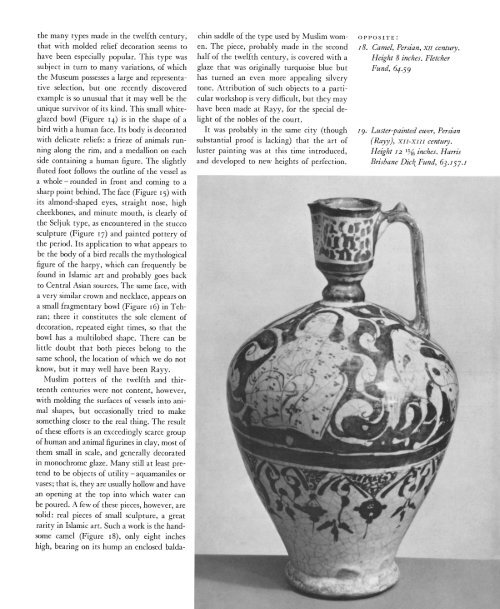Islamic Art: The Metropolitan Museum of Art Bulletin, v. 23, no. 6 ...
Islamic Art: The Metropolitan Museum of Art Bulletin, v. 23, no. 6 ...
Islamic Art: The Metropolitan Museum of Art Bulletin, v. 23, no. 6 ...
Create successful ePaper yourself
Turn your PDF publications into a flip-book with our unique Google optimized e-Paper software.
the many types made in the twelfth century,<br />
that with molded relief decoration seems to<br />
have been especially popular. This type was<br />
subject in turn to many variations, <strong>of</strong> which<br />
the <strong>Museum</strong> possesses a large and representative<br />
selection, but one recently discovered<br />
example is so unusual that it may well be the<br />
unique survivor <strong>of</strong> its kind. This small whiteglazed<br />
bowl (Figure 14) is in the shape <strong>of</strong> a<br />
bird with a human face. Its body is decorated<br />
with delicate reliefs: a frieze <strong>of</strong> animals running<br />
along the rim, and a medallion on each<br />
side containing a human figure. <strong>The</strong> slightly<br />
fluted foot follows the outline <strong>of</strong> the vessel as<br />
a whole-rounded in front and coming to a<br />
sharp point behind. <strong>The</strong> face (Figure I5) with<br />
its almond-shaped eyes, straight <strong>no</strong>se, high<br />
cheekbones, and minute mouth, is clearly <strong>of</strong><br />
the Seljuk type, as encountered in the stucco<br />
sculpture (Figure I7) and painted pottery <strong>of</strong><br />
the period. Its application to what appears to<br />
be the body <strong>of</strong> a bird recalls the mythological<br />
figure <strong>of</strong> the harpy, which can frequently be<br />
found in <strong>Islamic</strong> art and probably goes back<br />
to Central Asian sources. <strong>The</strong> same face, with<br />
a very similar crown and necklace, appears on<br />
a small fragmentary bowl (Figure i6) in Tehran;<br />
there it constitutes the sole element <strong>of</strong><br />
decoration, repeated eight times, so that the<br />
bowl has a multilobed shape. <strong>The</strong>re can be<br />
little doubt that both pieces belong to the<br />
same school, the location <strong>of</strong> which we do <strong>no</strong>t<br />
k<strong>no</strong>w, but it may well have been Rayy.<br />
Muslim potters <strong>of</strong> the twelfth and thirteenth<br />
centuries were <strong>no</strong>t content, however,<br />
with molding the surfaces <strong>of</strong> vessels into animal<br />
shapes, but occasionally tried to make<br />
something closer to the real thing. <strong>The</strong> result<br />
<strong>of</strong> these efforts is an exceedingly scarce group<br />
<strong>of</strong> human and animal figurines in clay, most <strong>of</strong><br />
them small in scale, and generally decorated<br />
in mo<strong>no</strong>chrome glaze. Many still at least pretend<br />
to be objects <strong>of</strong> utility -aquamaniles or<br />
vases; that is, they are usually hollow and have<br />
an opening at the top into which water can<br />
be poured. A few <strong>of</strong> these pieces, however, are<br />
solid: real pieces <strong>of</strong> small sculpture, a great<br />
rarity in <strong>Islamic</strong> art. Such a work is the handsome<br />
camel (Figure i8), only eight inches<br />
high, bearing on its hump an enclosed balda-<br />
chin saddle <strong>of</strong> the type used by Muslim women.<br />
<strong>The</strong> piece, probably made in the second<br />
half <strong>of</strong> the twelfth century, is covered with a<br />
glaze that was originally turquoise blue but<br />
has turned an even more appealing silvery<br />
tone. Attribution <strong>of</strong> such objects to a particular<br />
workshop is very difficult, but they may<br />
have been made at Rayy, for the special delight<br />
<strong>of</strong> the <strong>no</strong>bles <strong>of</strong> the court.<br />
It was probably in the same city (though<br />
substantial pro<strong>of</strong> is lacking) that the art <strong>of</strong><br />
luster painting was at this time introduced,<br />
and developed to new heights <strong>of</strong> perfection.<br />
OPPOSITE:<br />
18. Camel, Persian, xI century.<br />
Height 8 inches. Fletcher<br />
Fund, 64.59<br />
I9. Luster-painted ewer, Persian<br />
(Rayy), xiI-xiiI century.<br />
Height 12 1316 inches. Harris<br />
Brisbane Dick Fund, 63.I 57.

















